Evaluation of the Intrinsic and Perceived Quality of Sangiovese Wines from California and Italy
Abstract
:1. Introduction
2. Materials and Methods
2.1. Sangiovese Wine Samples
2.2. Intrinsic Quality: Chemical Characteristics for Measuring Eligibility, Identity, and Style Wine Properties
2.3. Intrinsic Quality: Sensory Attributes Measuring Eligibility, Identity, and Style Wine Properties
2.3.1. Selection of Samples
2.3.2. Training
2.3.3. Evaluation of Samples
2.4. Perceived Quality: Napping® Test, Wine Rating of Color and Typicality
2.5. Statistical Analyses
3. Results
3.1. Evaluation of the Intrinsic Chemical Quality of the Sangiovese Wines
3.2. Evaluation of the Intrinsic and Perceived Sensory Quality of the Sangiovese Wines
3.2.1. Evaluation of the Intrinsic Quality: Eligibility and Identity Sensory Profiles
3.2.2. Evaluation of the Perceived Quality: Napping® Test, Wine Rating of Color and Typicality
3.3. Relationship between Identity Profile and Typicality of Wines
4. Discussion
Supplementary Materials
Author Contributions
Funding
Acknowledgments
Conflicts of Interest
References
- Vouillamoz, J.O.S.; Monaco, A.; Costantini, L.; Stefanini, M.; Scienza, A.; Grando, M.S. The parentage of ‘Sangiovese’, the most important Italian wine grape. Vitis 2007, 46, 19–22. [Google Scholar] [CrossRef]
- Bergamini, C.; Caputo, A.R.; Gasparro, M.; Perniola, R.; Cardone, M.F.; Antonacci, D. Evidences for an alternative genealogy of ‘Sangiovese’. Molec. Biotech. 2013, 53, 278–288. [Google Scholar] [CrossRef] [PubMed]
- Registro Nazionale delle Varietà di Vite, Ministero delle Politiche Agricole, Alimentari e Forestali. Available online: http://catalogoviti.politicheagricole.it/catalogo.php (accessed on 9 August 2020).
- Various authors. In Il Sangiovese, Proceedings of the 1st International Sangiovese Symposium, Florence, Italy, 15−17 February 2000; Arsia: Florence, Italy, 2000.
- Various authors. In Il Sangiovese Vitigno Tipico e Internazionale: Identità e Peculiarità, Proceedings of the 2nd International Sangiovese Symposium, Florence, Italy, 17−19 November 2004; Arsia: Florence, Italy, 2004.
- Canuti, V.; Puccioni, S.; Storchi, P.; Zanoni, B.; Picchi, M.; Bertuccioli, M. Enological eligibility of grape clones based on the SIMCA method: The case of the Sangiovese cultivar from Tuscany. Ital. J. Food Sci. 2018, 30, 184–199. [Google Scholar] [CrossRef]
- Rinaldi, A.; Coppola, M.; Moio, L. Aging of Aglianico and Sangiovese wine on mannoproteins: Effect on astringency and colour. LWT 2019, 105, 233–241. [Google Scholar] [CrossRef]
- Rinaldi, A.; Louazil, P.; Iturmendi, N.; Moine, V.; Moio, L. Effect of marc pressing and geographical area on Sangiovese wine quality. LWT 2020, 118, 108728. [Google Scholar] [CrossRef]
- Canuti, V.; Frost, S.; Lerno, L.A.; Tanabe, C.K.; Zweigenbaum, J.; Zanoni, B.; Ebeler, S.E. Chemical Characteristics of Sangiovese Wines from California and Italy of 2016 Vintage. J. Agric. Food Chem. 2019, 67, 2647–2659. [Google Scholar] [CrossRef]
- Wang, J.; Capone, D.L.; Wilkinson, K.L.; Jeffery, D.W. Chemical and sensory profiles of rosé wines from Australia. Food Chem. 2016, 196, 682–693. [Google Scholar] [CrossRef]
- Sánchez-Palomo, E.; Delgado, J.A.; Ferrer, M.A.; Viñas, M.G. The aroma of La Mancha Chelva wines: Chemical and sensory characterization. Food Res. Int. 2019, 119, 135–142. [Google Scholar] [CrossRef]
- Kustos, M.; Gambetta, J.M.; Jeffery, D.W.; Heymann, H.; Goodman, S.; Bastian, S.E. A matter of place: Sensory and chemical characterisation of fine Australian Chardonnay and Shiraz wines of provenance. Food Res. Int. 2020, 130, 108903. [Google Scholar] [CrossRef]
- Zanoni, B.; Siliani, S.; Canuti, V.; Rosi, I.; Bertuccioli, M. A kinetic study on extraction and transformation phenomena of phenolic compounds during red wine fermentation. Int. J. Food Sci. Technol. 2010, 45, 2080–2088. [Google Scholar] [CrossRef]
- Urvieta, R.; Buscema, F.; Bottini, R.; Coste, B.; Fontana, A. Phenolic and sensory profiles discriminate geographical indications for Malbec wines from different regions of Mendoza, Argentina. Food Chem. 2018, 265, 120–127. [Google Scholar] [CrossRef] [PubMed]
- Valentin, L.; Barroso, L.P.; Barbosa, R.M.; de Paulo, G.A.; Castro, I.A. Chemical typicality of South American red wines classified according to their volatile and phenolic compounds using multivariate analysis. Food Chem. 2020, 302, 125340. [Google Scholar] [CrossRef] [PubMed]
- Fanzone, M.; Peña-Neira, A.; Jofré, V.; Assof, M.; Zamora, F. Phenolic characterization of Malbec wines from Mendoza province (Argentina). J. Agric. Food Chem. 2010, 58, 2388–2397. [Google Scholar] [CrossRef] [PubMed]
- Feher, I.; Magdas, D.A.; Dehelean, A.; Sârbu, C. Characterization and classification of wines according to geographical origin, vintage and specific variety based on elemental content: A new chemometric approach. J. Food Sci. Tech. 2019, 56, 5225–5233. [Google Scholar] [CrossRef] [PubMed]
- Pasvanka, K.; Tzachristas, A.; Kostakis, M.; Thomaidis, N.; Proestos, C. Geographic characterization of Greek wine by inductively coupled plasma-mass spectrometry macroelemental analysis. Anal. Let. 2019, 52, 2741–2750. [Google Scholar] [CrossRef]
- King, E.S.; Stoumen, M.; Buscema, F.; Hjelmeland, A.K.; Ebeler, S.E.; Heymann, H.; Boulton, R.B. Regional sensory and chemical characteristics of Malbec wines from Mendoza and California. Food Chem. 2014, 143, 256–267. [Google Scholar] [CrossRef]
- Fushing, H.; Lee, O.; Heitkamp, C.; Heymann, H.; Ebeler, S.E.; Boulton, R.B.; Koehl, P. Unraveling the Regional Specificities of Malbec Wines from Mendoza, Argentina, and from Northern California. Agronomy 2019, 9, 234. [Google Scholar] [CrossRef] [Green Version]
- Williamson, P.O.; Robichaud, J.; Francis, I.L. Comparison of Chinese and Australian consumers’ liking responses for red wines. Aust. J. Grape Wine Res. 2012, 18, 256–267. [Google Scholar] [CrossRef]
- Green, J.A.; Parr, W.V.; Breitmeyer, J.; Valentin, D.; Sherlock, R. Sensory and chemical characterisation of Sauvignon blanc wine: Influence of source of origin. Food Res. Int. 2011, 44, 2788–2797. [Google Scholar] [CrossRef]
- Lund, C.M.; Thompson, M.K.; Benkwitz, F.; Wohler, M.W.; Triggs, C.M.; Gardner, R.; Heymann, H.; Nicolau, L. New Zealand Sauvignon blanc distinct flavour characteristics: Sensory, chemical, and consumer aspects. Am. J. Enol. Vit. 2009, 60, 1–12. [Google Scholar]
- Lecat, B.; Chapuis, C. Food and Wine Pairing in Burgundy: The Case of Grands Crus. Beverages 2017, 3, 10. [Google Scholar] [CrossRef] [Green Version]
- Luykx, D.M.A.M.; Van Ruth, S.M. An overview of analytical methods for determining the geographical origin of food products. Food Chem. 2008, 107, 897–911. [Google Scholar] [CrossRef]
- Maitre, I.; Symoneaux, R.; Jourjon, F.; Mehinagic, E. Sensory typicality of wines: How scientists have recently dealt with this subject. Food Qual. Pref. 2010, 21, 726–731. [Google Scholar] [CrossRef]
- Salette, J. La tipicité: Une notion nouvelle au service du produit, de ceux qui l’élaborent, et de ceux qui le consomment en l’appréciant. Rev. OEnol. Tech. Vit. Oen. 1997, 24, 11–13. [Google Scholar]
- Seguin, G. Influence Des Terroirs Viticoles Sur La Constitution et La Qualite Des Vendanges. Bull. OIV 1983, 56, 3–18. [Google Scholar]
- Van Leeuwen, C.; Seguin, G. The concept of terroir in viticulture. J. Wine Res. 2006, 17, 1–10. [Google Scholar] [CrossRef]
- Webb, L.B.; Whetton, P.H.; Barlow, E.W.R. Climate change and winegrape quality in Australia. Clim. Res. 2008, 36, 99–111. [Google Scholar] [CrossRef]
- Van Leeuwen, C.; Tregoat, O.; Choné, X.; Bois, B.; Pernet, D.; Gaudillère, J.P. Vine water status is a key factor in grape ripening and vintage quality for red Bordeaux wine. How can it be assessed for vineyard management purposes? OENO One 2009, 43, 121–134. [Google Scholar] [CrossRef]
- Van Leeuwen, C.; Darriet, P. The impact of climate change on viticulture and wine quality. J. Wine Econ. 2016, 11, 150–167. [Google Scholar] [CrossRef] [Green Version]
- Casabianca, F.; Sylvander, B.; Noel, Y.; Béranger, C.; Coulon, J.B.; Giraud, G.; Flutet, G.; Roncin, F.; Vincent, E. Terroir et Typicité: Propositions de définitions pour deux notions essentielles à l’appréhension des Indications Géographiques et du développement durable. In VIe Congrès International Sur Les Terroirs Viticoles; Bordeaux-Montpellier: Corte, France, 2006. [Google Scholar]
- Bertuccioli, M.; Rosi, I.; Canuti, V.; Giovani, G.; Picchi, M. La tipicità dei vini: Il Sangiovese. Ind. Bevande 2011, 40, 7–14. [Google Scholar]
- Canuti, V.; Picchi, M.; Zanoni, B.; Fia, G.; Bertuccioli, M. A Multivariate Methodological Approach to Relate Wine to Characteristics of Grape Composition: The Case of Typicality. Am. J. Enol. Vitic. 2017, 68, 49–59. [Google Scholar] [CrossRef]
- Parr, W.V.; Green, J.A.; White, K.G.; Sherlock, R.R. The distinctive flavour of New Zealand Sauvignon blanc: Sensory characterisation by wine professionals. Food Qual. Pref. 2007, 18, 849–861. [Google Scholar] [CrossRef]
- Glories, Y. La couleur des vins rouges II. Connaissance de la Vigne et du vin 1984, 18, 253–271. [Google Scholar]
- Ribereau-Gayon, P. Le dosage des composés phénoliques totaux dans les vins rouges. Chim. Anal. 1970, 52, 627–631. [Google Scholar]
- Girardello, R.C.; Cooper, M.L.; Smith, R.J.; Lerno, L.A.; Bruce, R.C.; Eridon, S.; Oberholster, A. Impact of grapevine red blotch disease on grape composition of Vitis vinifera cabernet sauvignon, merlot, and chardonnay. J. Agric. Food Chem. 2019, 67, 5496–5511. [Google Scholar] [CrossRef]
- Canuti, V.; Conversano, M.; Li Calzi, M.; Heymann, H.; Matthews, M.A.; Ebeler, S.E. Headspace solid-phase microextraction-gaschromatography-mass spectrometry for profiling free volatile compounds in Cabernet Sauvignon grapes and wines. J. Chrom. A 2009, 1216, 3012–3022. [Google Scholar] [CrossRef]
- Ballester, J.; Dacremont, C.; Le Fur, Y.; Etiévant, P. The role of olfaction in the elaboration and use of the Chardonnay wine concept. Food Qual. Pref. 2005, 16, 351–359. [Google Scholar] [CrossRef]
- Pagès, J. Recueil direct de distances sensorielles: Application à l’évaluation de dix vins blancs du Val-de-Loire. Sci. Al. 2003, 23, 679–688. [Google Scholar] [CrossRef]
- Risvik, E.; McEwan, J.A.; Colwill, J.S.; Rogers, R.; Lyon, D.H. Projective mapping: A tool for sensory analysis and consumer research. Food Qual. Pref. 1994, 5, 263–269. [Google Scholar] [CrossRef]
- Escoffier, B.; Pagès, J. Multi factor analysis (AFMULT pack-age). Comput. Stat. Data Anal. 1994, 18, 121–140. [Google Scholar] [CrossRef]
- Pagès, J.; Husson, F. Inter-laboratory comparison of sensory profiles: Methodology and results. Food Qual. Pref. 2001, 12, 297–309. [Google Scholar] [CrossRef]
- Picchi, M.; Canuti, V.; Bertuccioli, M.; Zanoni, B. The Influence of Conventional and Biodynamic Winemaking Processes on the Quality of Sangiovese Wine. Int. J. Wine Res. 2020, 12, 1. [Google Scholar] [CrossRef] [Green Version]
- Mateo, J.J.; Jiménez, M. Monoterpenes in grape juice and wines. J. Chrom. A 2000, 881, 557–567. [Google Scholar] [CrossRef]
- Hopfer, H.; Heymann, H. Judjung wine quality: Do we need experts, consumers or trained panelists? Food Qual. Pref. 2014, 32, 221–233. [Google Scholar] [CrossRef]
- Sáenz-Navajasa, M.P.; Ballester, J.; Pêchera, C.; Peyrona, D.; Valentin, D. Sensory drivers of intrinsic quality of red wines: Effect of culture and level of expertise. Food Res. Int. 2013, 54, 1506–1518. [Google Scholar] [CrossRef]
- Love, J. The U.S. Wine Industry Uncorked. USDA; 1997. Available online: https://wayback.archive-it.org/5923/20110903235932/http://ers.usda.gov/publications/agoutlook/aug1997/ao243c1.pdf (accessed on 9 August 2020).
- Garrido, J.; Borges, F. Wine and grape polyphenols—A chemical perspective. Food Res. Int. 2013, 54, 1844–1858. [Google Scholar] [CrossRef] [Green Version]
- Bramley, R.G.; Hamilton, R.P. Terroir and precision viticulture: Are they compatible? J. Int. Sci. Vigne Vin 2007, 41, 1–8. [Google Scholar] [CrossRef]
- Chapman, D.M.; Matthews, M.A.; Guinard, J.X. Sensory attributes of Cabernet Sauvignon wines made from vines with different crop yields. Am. J. Enol. Vitic. 2004, 55, 325–334. [Google Scholar]
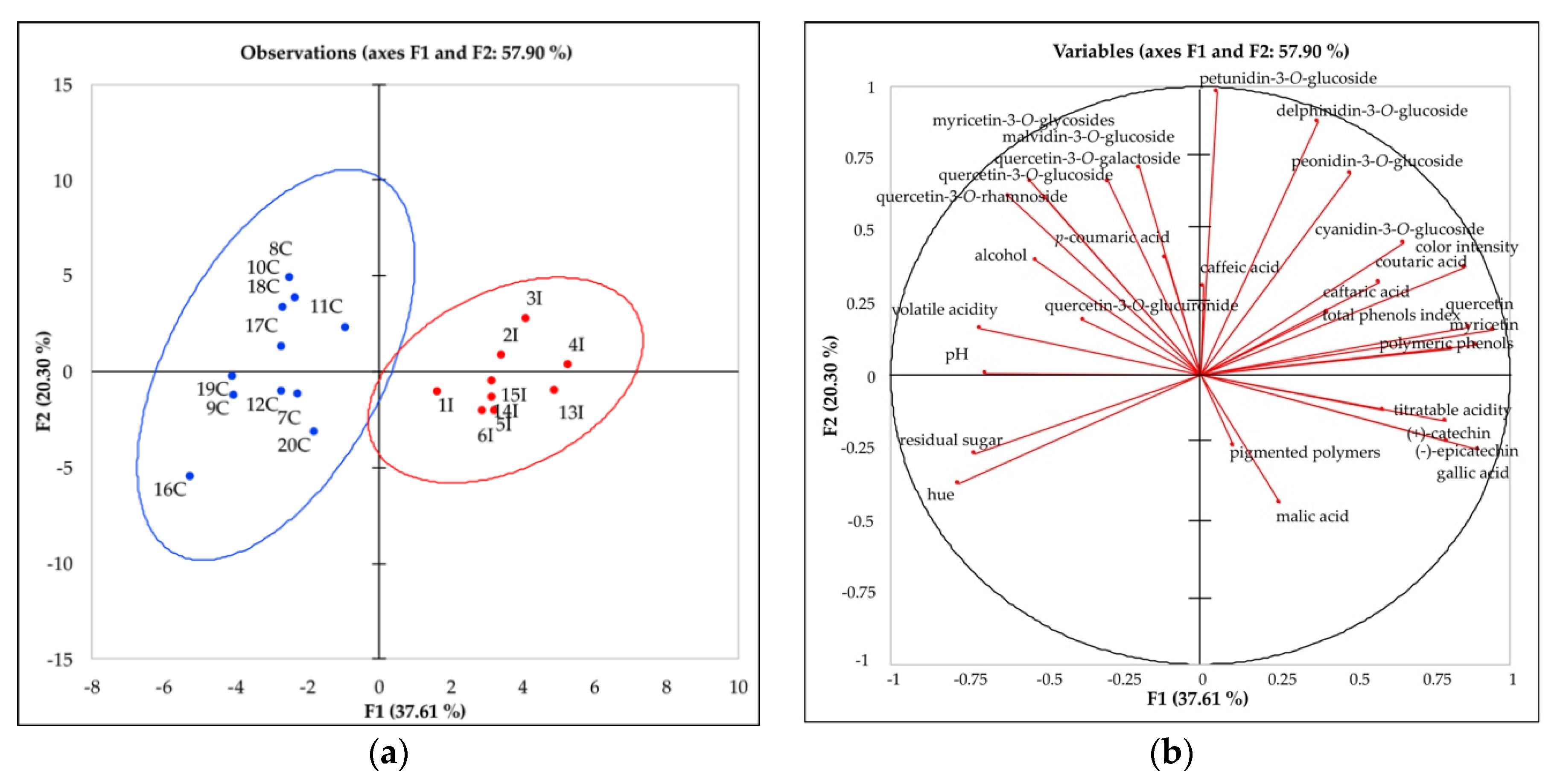
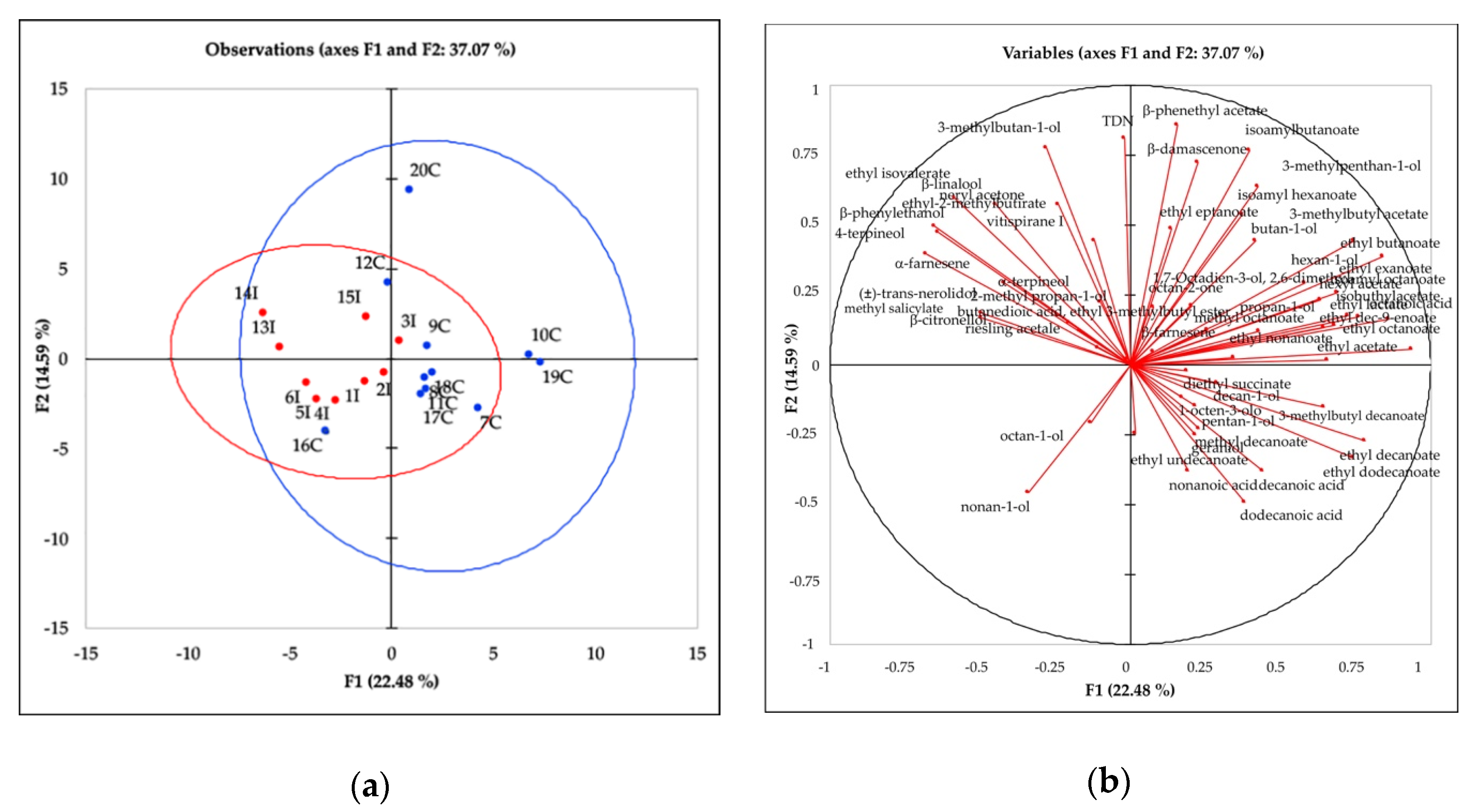
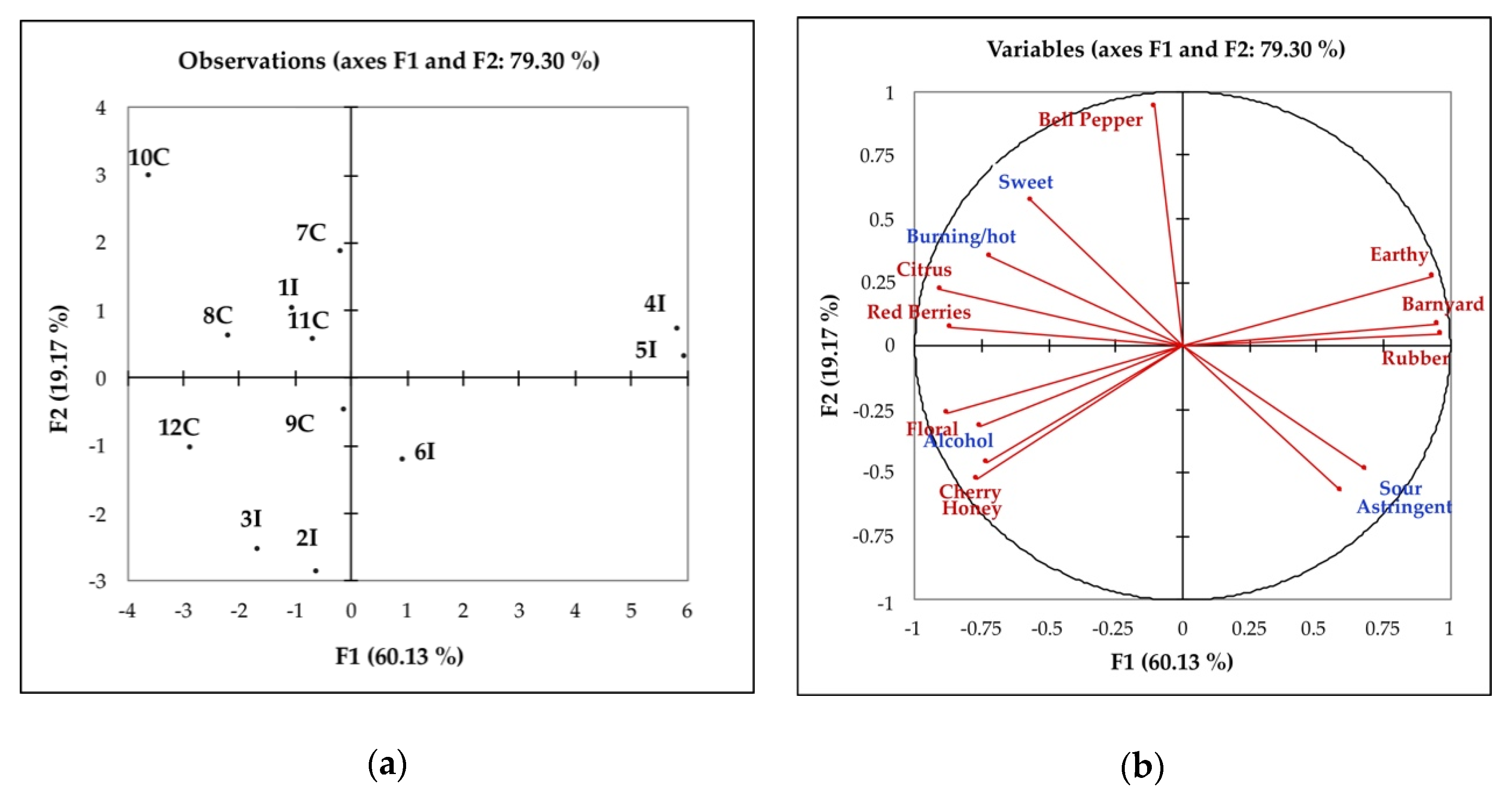

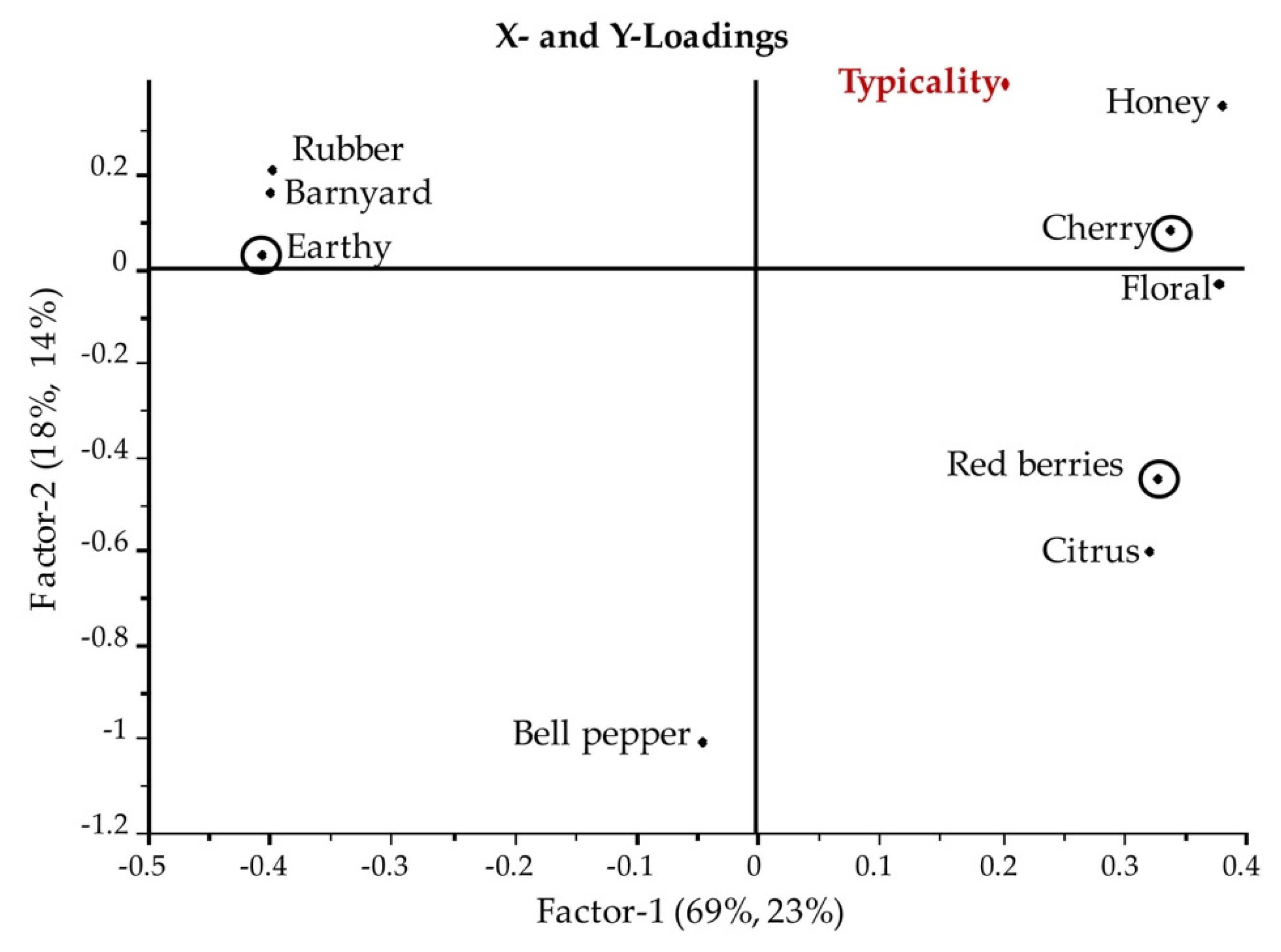
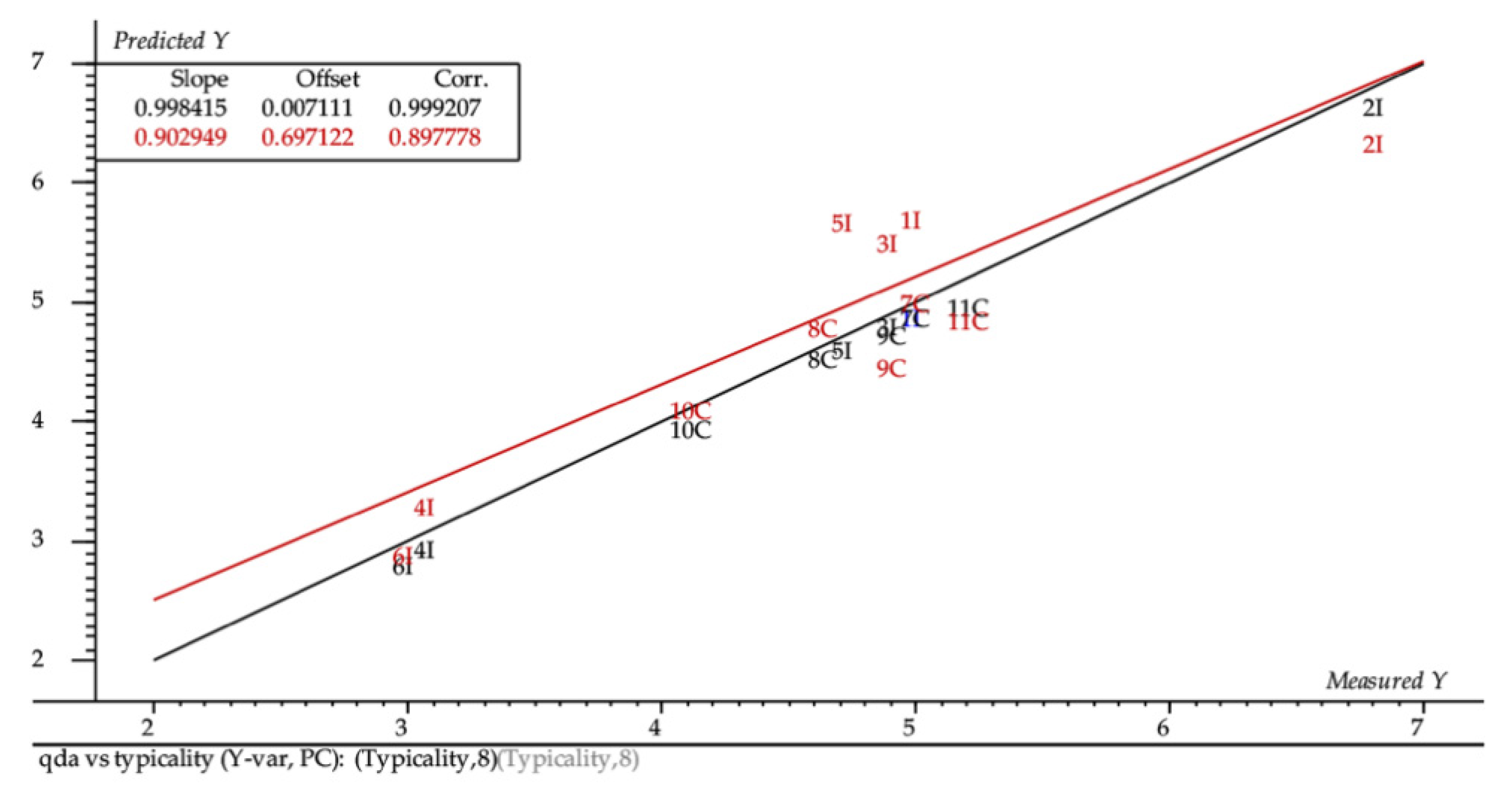

| Wine Code | State/ Country | Region | Alcohol (v/v%) | Residual Sugar (g/L) | Titratable Acidity (g/L) | Volatile Acidity (g/L) | pH | Malic Acid (g/L) |
|---|---|---|---|---|---|---|---|---|
| 1I | Italy | Chianti Classico (Tuscany) | 13.65 | <1 | 5.36 | 0.48 | 3.55 | 0.00 |
| 2I | Italy | Chianti Classico (Tuscany) | 13.30 | <1 | 6.32 | 0.39 | 3.38 | 0.00 |
| 3I | Italy | Chianti Classico (Tuscany) | 14.26 | <1 | 5.85 | 0.29 | 3.45 | 0.00 |
| 4I | Italy | Chianti Classico (Tuscany) | 12.65 | <1 | 5.80 | 0.42 | 3.31 | 0.00 |
| 5I | Italy | Chianti Classico (Tuscany) | 13.85 | 1 | 7.60 | 0.35 | 3.24 | 0.17 |
| 6I | Italy | Chianti Classico (Tuscany) | 14.04 | 1.12 | 5.18 | 0.43 | 3.42 | 0.19 |
| 13I | Italy | Chianti (Tuscany) | 14.23 | <1 | 6.48 | 0.52 | 3.31 | 0.85 |
| 14I | Italy | Chianti (Tuscany) | 14.05 | 2.12 | 6.37 | 0.37 | 3.29 | 0.93 |
| 15I | Italy | Montalcino (Tuscany) | 14.45 | 0.23 | 6.82 | 0.21 | 3.43 | 0.90 |
| 7C | California | Napa Valley (North Coast) | 13.32 | 2.59 | 4.60 | 0.54 | 3.72 | 0.09 |
| 8C | California | Santa Ynez valley (Central Coast) | 15.18 | 3.56 | 5.00 | 0.66 | 3.58 | 0.08 |
| 9C | California | Napa Valley (North Coast) | 14.17 | 3.27 | 6.03 | 0.72 | 3.59 | 0.00 |
| 10C | California | Alameda County (Central Coast) | 15.38 | 2.78 | 4.76 | 0.59 | 3.68 | 0.00 |
| 11C | California | Napa Valley (North Coast) | 14.90 | 1.88 | 4.13 | 0.55 | 3.79 | 0.09 |
| 12C | California | Amador County (Sierra Foothills) | 13.88 | 2.64 | 5.48 | 0.53 | 3.43 | 0.00 |
| 16C | California | Saint Joacquin valley (Inland Valley) | 14.67 | 8.37 | 3.58 | 0.74 | 4.01 | 0.33 |
| 17C | California | Napa Valley (North Coast) | 14.42 | 2.30 | 4.33 | 0.73 | 4.00 | 0.49 |
| 18C | California | Santa Ynez valley (Central Coast) | 15.39 | 3.16 | 5.98 | 0.64 | 3.38 | 0.13 |
| 19C | California | Paso Robles (Central Coast) | 14.61 | 1.83 | 4.96 | 0.53 | 3.60 | 0.00 |
| 20C | California | Amador County (Sierra Foothills) | 14.58 | 2.89 | 6.77 | 0.26 | 3.42 | 1.27 |
| Taste and Mouthfeel | Recipe | Product |
|---|---|---|
| Sour | 2 g/L citric acid | Millard citric acid |
| Sweet | 12 g/L cane sugar | C&H |
| Bitter | 1.6 g/L caffeine | Sigma & Aldrich, food grade |
| Viscous | 4 g/L CMC | Sigma & Aldrich, food grade |
| Astringent | 1 g/L alum | McCormick |
| Hot/Burning | 250 mL vodka/L | Smirnoffs |
| Aroma | Recipe | Product |
| Citrus | 1 quarter whole fresh grapefruit, and a quarter of a whole fresh lemon | fresh produce, ruby red grapefruit, lemon |
| Floral | 8 drops rose water, 8 drops orange blossom water and 8 drops violet syrup in 15 mL wine * | Sadaf Orange blossom water, Carlo Rose Water, Monin Violet syrup |
| Black pepper | 1/8 teaspoon ground black pepper | Morton & Bassett, San Francisco Whole black pepper |
| Dried fruit | 1 tsp dried figs, 1 tsp dried apricots (non-sulfured) and 1 tsp raisins | Sunsweet dates (chopped); Sunmaid raisins, sun-dried; unsulfured, Organic Malatya Apricots, by Mariani |
| Barnyard | 1/8 tsp of ground white pepper in 30 mL of water | Morton & Bassett, San Francisco Whole White Pepper |
| Dark Fruit | 5 mL Prune juice, 5 mL blackcurrant juice and 1 tablespoon blackberry jam | SunsweetTM Ribena black currant juice; Bon mamman blackberry jam |
| Rubber | 1/2 new rubber bike hose in small pieces | Target brand |
| Cherry | 1 tsp red tart cherry juice, 4 cherries | Red tart cherries in water, Oregon specialty fruits |
| Alcohol | 20 mL of vodka and 10 mL of wine * | Smirnoff, Vodka |
| Honey | 2 tsp raw honey | Nature Nate’s 100% Raw & Unfiltered Honey |
| Oak | 2 small pieces of American oak, 10 drops of water | Evoak, large chips, heavy roast |
| Red berries | 1 fresh strawberries, 2 fresh raspberries | Driscolls fresh fruits |
| Earthy | 1 tablespoon potting soil, 5 mL water and 5 mL wine * | Miracle Gro Potting Mix |
| Bell pepper | 5 g green bell pepper and 2 green beans | Fresh green bean and bell pepper purchased locally |
| Wine | Typicality Score | Color Score |
|---|---|---|
| 1I | 8.36 ab | 3.45 d |
| 2I | 9.54 a | 4.00 bcd |
| 2I (replicate) | 8.63 ab | 4.73 ab |
| 3I | 8.09 bc | 4.82 a |
| 4I | 6.73 cd | 4.18 abcd |
| 5I | 8.00 bcd | 4.18 abcd |
| 6I | 6.64 d | 4.27 abcd |
| 7C | 8.36 ab | 3.54 d |
| 8C | 8.27 ab | 4.36 abc |
| 9C | 7.91 bcd | 2.18 e |
| 10C | 7.45 bcd | 3.54 d |
| 11C | 8.54 ab | 3.91 cd |
| F-value sample | 2.51 | 5.72 |
| p-value sample | 0.0074 | 0.0000 |
| Standard error sample | 0.51 | 0.29 |
| Average Italian | 8.00 a | 4.23 b |
| Average Californian | 8.11 a | 3.51 a |
| F-value region | 0.93 | 5.27 |
| p-value region | 0.3370 | 0.0234 |
© 2020 by the authors. Licensee MDPI, Basel, Switzerland. This article is an open access article distributed under the terms and conditions of the Creative Commons Attribution (CC BY) license (http://creativecommons.org/licenses/by/4.0/).
Share and Cite
Canuti, V.; Cantu, A.; Picchi, M.; Lerno, L.A.; Tanabe, C.K.; Zanoni, B.; Heymann, H.; Ebeler, S.E. Evaluation of the Intrinsic and Perceived Quality of Sangiovese Wines from California and Italy. Foods 2020, 9, 1088. https://doi.org/10.3390/foods9081088
Canuti V, Cantu A, Picchi M, Lerno LA, Tanabe CK, Zanoni B, Heymann H, Ebeler SE. Evaluation of the Intrinsic and Perceived Quality of Sangiovese Wines from California and Italy. Foods. 2020; 9(8):1088. https://doi.org/10.3390/foods9081088
Chicago/Turabian StyleCanuti, Valentina, Annegret Cantu, Monica Picchi, Larry A. Lerno, Courtney K. Tanabe, Bruno Zanoni, Hildegarde Heymann, and Susan E. Ebeler. 2020. "Evaluation of the Intrinsic and Perceived Quality of Sangiovese Wines from California and Italy" Foods 9, no. 8: 1088. https://doi.org/10.3390/foods9081088






